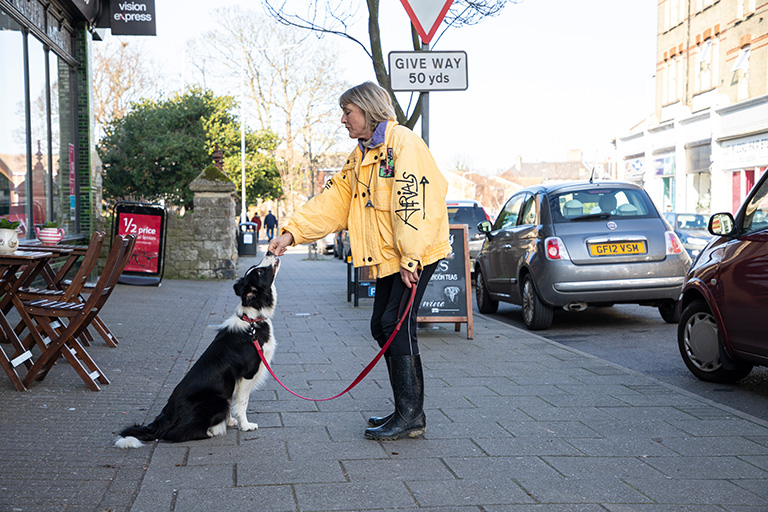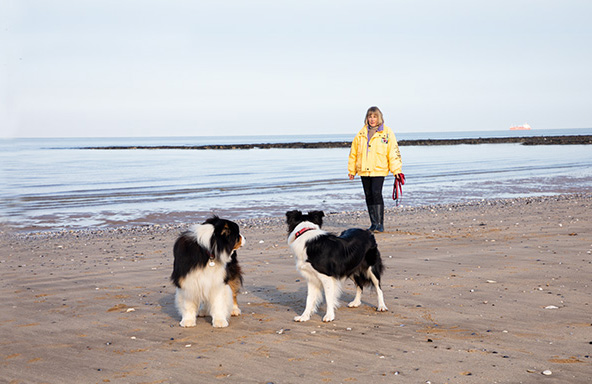Training is the key to getting your dog more focused on you. Carol Price explains how.
Start by getting your dog to look at you and try to hold his attention, rewarding with a treat or toy, whichever he prefers.
Step 1: Watch me
The very first thing I do in training with any dog or puppy is see how long I can hold his attention. I show him a tasty treat in my hand, then move this hand to my face with my index finger pointing up between my eyes (see image). This way, when the dog looks up to the hand holding the treat, he is already watching me and making eye contact, at which point I will say ‘Watch me’, then reward him with the treat for doing so. I then see how long I can keep him watching me in this way before his attention breaks off again, and he looks or runs off elsewhere.
I do not touch the dog, or say anything else to the dog during this exercise, or say anything when he chooses to break his attention from me. Nor does it matter what position he is in initially when I ask him to watch me, although most dogs will naturally sit in expectation of a treat. All that matters is that he has chosen the option to watch me by himself, and discovered how rewarding this can be.
From this point — and still without doing or saying anything else as the dog watches me — I will try to stretch out the amount of time during which I can hold his attention in this way before I give him his reward.
Always begin this training in a place where there are the least amount of surrounding distractions (at home for instance). Some dogs have naturally longer attention spans when you start this exercise, other dogs will have incredibly short ones. But, in the latter case, this is often a behaviour that develops, or gets learned, from past experience.

1. Place a treat in your hand.
2. Show your dog the treat.
3. Close your hand and bring it up to your face with your forefinger between your eyes, as you say ‘Watch me.’
Step 2: Watch me and wait in different positions
After you have got your dog watching you reliably, the next step is to get him to watch you when he is in different positions — sitting, standing, lying down — and also ask him to wait. Your dog must have already been taught to sit, lie down, and wait on command.
Once your dog is in your chosen position, walk a complete circle around him while you continue to ask him to ‘Watch me’ and ‘Wait’. Reward him really well with a treat for doing so. If your dog ever stops watching you or moves again, just keep gently repeating the exercise until he gets it right.
If your dog is more toy than food orientated in training, you can use his favourite toys as rewards instead in focus and cooperation exercises.
Practise the watch me with your dog in different positions.
Step 3: Watch me and wait before anything good happens
Once you have mastered basic watch me and wait training with your dog, the next step is to ensure you ask your dog to watch you and wait for at least five to 10 seconds before anything good or exciting happens in his life — before he has a meal, or treat, or toy, or before you go out for a walk, or just before you let him out of the car when you get to a walk, or just before you let him off the lead when you arrive at a walk. This way your dog will increasingly associate watching you and waiting as the gateway behaviours to all the best things that happen in his life.
This kind of training also really helps dogs develop better impulse control.
Teach your dog to watch and wait before anything exciting happens.


Watching and waiting before exiting the car or starting a walk.
Step 4: Upping the levels of surrounding distraction
Once your watch me and wait exercises are going well at home, try doing them in all sorts of different places when you are out, gradually upping the level of surrounding distraction your dog has to screen out (for instance other people, dogs, noise, traffic), while still focusing on you and cooperating with you through waiting.
Teach your dog to focus on you through many surrounding distractions.
Remember to reward well.
Step 5: Checking back and watching when you are out
Many owners may find their dogs’ attention on them rapidly declines once they are out on a walk, and there are countless other distractions competing for their attention. For this reason, as well as constantly working on step 4 (training through distractions), always get into the habit — preferably from as early an age as possible — of doing the following.
Each and every time your dog runs back to you on a walk, of his own accord, praise and reward him with a really tasty treat. Not only that, but every time your dog even looks at you, or looks back at you, on a walk do the same, until this continual checking back on you during a walk becomes a more ingrained habit in him. At this stage, you will only need to reward him randomly for focusing back on you, or just for super-fast responses whenever you need to call him to you.
Initially, it is always preferable to wait until your dog chooses to look at you, or runs back to you on a walk, before rewarding him, to ensure stronger and more reliable future responses of this kind. Training like this also forms a crucial foundation to better recall training, as it is always easier to get back a dog who is frequently watching you, and finds returning to you a consistently rewarding behaviour.
Reward your dog well when he checks back with you or just looks at you on walks.
The importance of impulse control in dogs
Along with poor owner focus, one of the commonest problems I see in modern dogs is poor impulse control — or the dog’s inability to stop emotions like anxiety, excitement, or frustration exploding outwards into more excitable, reckless, or dangerous physical reactions like aggression.
Sometimes there can be deeper genetic or environmental components driving this hotter-headed behaviour in dogs. But poorer focus and impulse control are also both classic products of a mind that has never been sufficiently trained or conditioned to work in a more disciplined way, through the kind of training outlined in this feature.
Owners can also make this problem even worse in their dogs by constantly shouting at them or otherwise chastising them for their more reactive behaviour, which just further accelerates their levels of emotional arousal. Understand that being a calmer and quieter owner is the essential pre-requisite to training your dog to be calmer and more focused too.
Teaching dogs to find eye contact rewarding can also make them far more at ease with a camera.
Why won’t my dog concentrate on me?
If you are having difficulty getting your dog to watch you for any length of time, here are some possible reasons:
● Initially, your dog finds direct eye contact with you more worrying or threatening. The solution: place your hand with the treat and finger pointing up (see page 23) on your chest initially, rather than between your eyes, so he can watch the hand here instead. Then, only gradually, over time, once he is better used to this, lift your hand higher up to your face.
● You have rewarded your dog more immediately in the past for, say, sitting and watching you for only an instant, which means his attention span has become only an instant too. You need to steadily lengthen the amount of time your dog has to watch you before being rewarded, in order to lengthen his attention span.
● You are expecting your dog to focus for longer on you before he has learned to concentrate through surrounding distractions (see step 4).
















